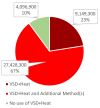The Rise of Heatstroke as a Method of Depopulating Pigs and Poultry: Implications for the US Veterinary Profession
- PMID: 36611748
- PMCID: PMC9817707
- DOI: 10.3390/ani13010140
The Rise of Heatstroke as a Method of Depopulating Pigs and Poultry: Implications for the US Veterinary Profession
Abstract
Depopulation of food-producing animals is becoming increasingly common in response to both disease outbreaks and supply chain disruptions. In 2019, the American Veterinary Medical Association released depopulation guidelines classifying certain heatstroke-based killing methods as "permitted in constrained circumstances", when circumstances of the emergency constrain reasonable implementation of "preferred" methods. Since then, tens of millions of birds and pigs have been killed by such methods, termed ventilation shutdown (VSD) Plus Heat and VSD Plus High Temperature and Humidity. While no research using validated measures of animal welfare assessment has been performed on these methods, their pathophysiology suggests that animals are likely to experience pain, anxiety, nausea, and heat distress prior to loss of consciousness. Heatstroke-based methods may result in prolonged suffering and often do not achieve 100% mortality. Potential and available alternative depopulation methods are briefly reviewed. The veterinary profession's ethical obligation to protect animal welfare in the context of depopulations is discussed.
Keywords: animal welfare; animal-derived foods (ADF); euthanasia; farm animal; highly pathogenic avian influenza (HPAI); livestock; on-farm emergency killing; swine; ventilation shutdown (VSD); veterinary ethics.
Conflict of interest statement
The authors declare no conflict of interest.
Figures



References
-
- Greenwald G. Hidden Video and Whistleblower Reveal Gruesome Mass-Extermination Method for Iowa Pigs Amid Pandemic. The Intercept. [(accessed on 20 September 2022)]. Available online: https://theintercept.com/2020/05/29/pigs-factory-farms-ventilation-shutd...
-
- USDA Final Responses to FOIA Request Numbers: APHIS- 02403-F. (February 2022), 2022-APHIS-02981-F (March 2022), 2022-APHIS-03427-F (April 2022), 2022-APHIS-03876-F (May 2022), 2022-APHIS-04627-F (June 2022), 2022-APHIS-04840-F (July 2022), 2022-APHIS-05330-F (August 2022), and 2022-APHIS-05448-F (Records missing from previous requests) [(accessed on 27 December 2022)]. Available online: https://awionline.org/sites/default/files/uploads/documents/Bird-Depopul....
-
- APHIS USDA APHIS|2022 Confirmations of Highly Pathogenic Avian Influenza in Commercial and Backyard Flocks. USDA Animal and Plant Health Inspection Service. [(accessed on 10 November 2022)]; Available online: https://www.aphis.usda.gov/aphis/ourfocus/animalhealth/animal-disease-in....
-
- USDA Final Report for the 2014–2015 Outbreak of Highly Pathogenic Avian Influenza (HPAI) in the United States.; 2016. [(accessed on 9 September 2022)]; Available online: https://www.aphis.usda.gov/animal_health/emergency_management/downloads/....
LinkOut - more resources
Full Text Sources
Research Materials

